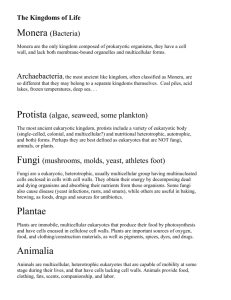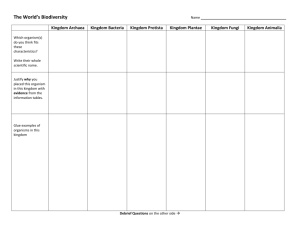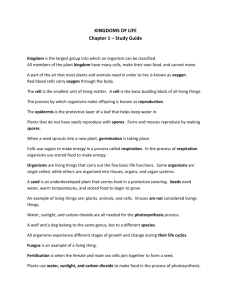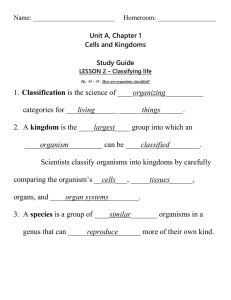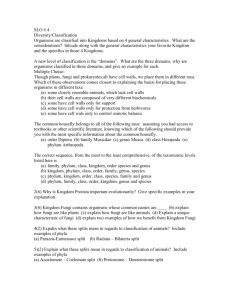Classification Review
advertisement
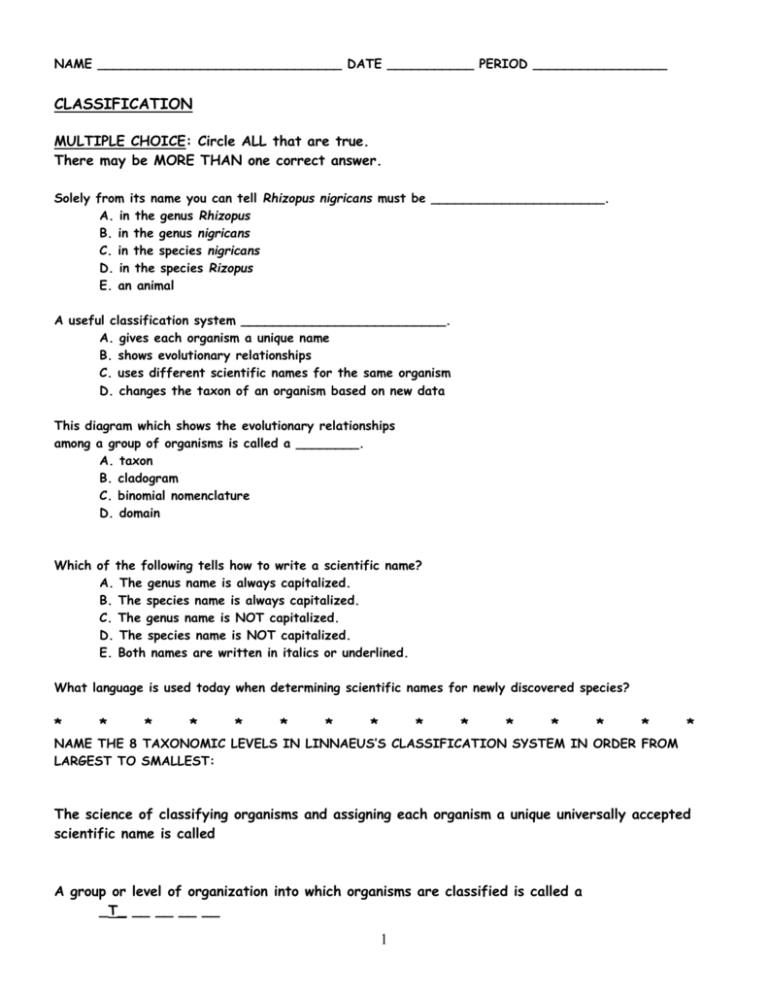
NAME _______________________________ DATE ___________ PERIOD _________________ CLASSIFICATION MULTIPLE CHOICE: Circle ALL that are true. There may be MORE THAN one correct answer. Solely from its name you can tell Rhizopus nigricans must be ______________________. A. in the genus Rhizopus B. in the genus nigricans C. in the species nigricans D. in the species Rizopus E. an animal A useful classification system __________________________. A. gives each organism a unique name B. shows evolutionary relationships C. uses different scientific names for the same organism D. changes the taxon of an organism based on new data This diagram which shows the evolutionary relationships among a group of organisms is called a ________. A. taxon B. cladogram C. binomial nomenclature D. domain Which of the following tells how to write a scientific name? A. The genus name is always capitalized. B. The species name is always capitalized. C. The genus name is NOT capitalized. D. The species name is NOT capitalized. E. Both names are written in italics or underlined. What language is used today when determining scientific names for newly discovered species? * * * * * * * * * * * * * * * NAME THE 8 TAXONOMIC LEVELS IN LINNAEUS’S CLASSIFICATION SYSTEM IN ORDER FROM LARGEST TO SMALLEST: The science of classifying organisms and assigning each organism a unique universally accepted scientific name is called A group or level of organization into which organisms are classified is called a _T_ __ __ __ __ 1 Large taxonomic group made up of closely related phyla that is the top level in Linnaeus’s classification hierarchy = _K_ ____ __ __ __ __ Greek philosopher who first classified organisms as plants or animals = _A_ __ __ __ __ __ __ __ __ A characteristic that appears in recent parts of a lineage, but not in its older members = _D_ __ __ __ __ __ __ _C_ __ __ __ __ __ __ __ __ A _P_ __ __ __ __ __ is a group of closely related classes. _B_ __ __ __ __ __ __ __ _N_ __ __ __ __ __ __ __ __ __ __ __ is the classification system in which each species is assigned a two-part scientific name A _C_ __ __ __ __ __ __ __ __ is a diagram that shows the evolutionary relationships among a group of organisms An organism that CAN’T make its own food and gets is energy from consuming other organisms = _H_ __ __ __ __ __ __ __ __ __ __ Domain of all organisms whose cells have nuclei, including protists, plants, fungi, and animals = _E_ __ __ __ __ __ __ Polysaccharide found in the cell walls of fungi = _C_ __ __ __ __ __ Organism that can make its own food using photosynthesis or chemosynthesis = _A_ __ __ __ __ __ __ __ __ An organism that “likes” high salt environments = _H_ __ __ __ __ __ __ __ __ Kingdom of multicellular eukaryotic heterotrophs whose cells DO NOT have cell walls or chloroplasts = _A_ __ __ __ __ __ __ __ Kingdom of “ancient” unicellular prokaryotes whose cell walls do not contain peptidoglycan and are often found in harsh environments such as volcano hot springs, brine pools, and other anaerobic conditions = _A_ __ __ __ __ __ __ __ __ __ __ __ __ __ Kingdom of unicellular prokaryotes whose cell walls are made of peptidoglycan = _E_ __ __ __ __ __ __ __ __ __ Kingdom composed of eukaryotes that are not classified as plants, animals, or fungi = _P_ __ __ __ __ __ __ __ 2 Kingdom composed of heterotrophs including mushrooms, toadstools, and yeast that obtain energy and nutrients from dead organic matter = _F_ __ __ __ __ Kingdom multicellular photosynthetic autotrophs that have cells walls containing cellulose and chloroplasts = _P_ __ __ __ __ __ __ Part of a scientific name that is always capitalized = _G_ __ __ __ __ Group of similar orders = _C_ __ __ __ __ Group of similar families = _O_ __ __ __ __ A _D_ __ __ __ __ __ __ __ __ __ __ _K_ __ __ is a series of paired statements that describe characteristics of different organisms that can be used to classify and identify living things. Substance made of sugars and peptides that is found in the cell walls of Eubacteria = _P_ __ __ __ __ __ __ __ __ __ __ __ __ Polysaccharide made by joining glucose subunits which makes plants and some protists sturdy = _C_ __ __ __ __ __ __ __ __ * * * * * _________________________ * * * * * __________________________ * * * __________________________ Name the SIX KINGDOMS used to classify organisms: _________________________ __________________________ ________________________ ________________________ ________________________ ________________________ * * * * * * * * * * * * * MATCH EACH KINGDOM BELOW WITH ITS DOMAIN: BACTERIA ARCHAEA EUKARYA __________________ PROTISTA ________________ ARCHAEBACTERIA __________________ EUBACTERIA _________________ PLANTAE ___________________ FUNGI __________________ ANIMALIA 3 * * * * * * * * * * * * * * * * * MATCHING: Match the description of organisms with its KINGDOM: _______ Eukaryotic heterotrophs whose cell walls contain chitin A. B. C. D. E. F. _____ Prokaryotes whose cell walls contain peptidoglycan ______ Multicellular autotrophs with chloroplasts whose cell walls contain cellulose EUBACTERIA ARCHAEBACTERIA PROTISTA PLANTAE FUNGI ANIMALIA ______ Prokaryotes whose cell walls lack peptidoglycan _____ Heterotrophic multicellular eukaryotes without cell walls or chloroplasts _____ Unicellular, colonial, or multicellular eukaryotes that show the widest variety of characteristics * * * * * * * * * * * * * * * On the line below the picture, label each organism with the KINGDOM and DOMAIN to which it belongs. KINGDOM ___________________ KINGDOM _____________________ DOMAIN _____________________ DOMAIN ________________________ KINGDOM ______________ KINGDOM ____________ DOMAIN _______________ DOMAIN ___________ 4 KINGDOM: _______________ DOMAIN _________________ * * Refer to A. B. C. D. * * * * * * * * * * * * the illustration above, the branching diagram like the one shown is called a Phentic tree Cladogram Family Tree Homology Refer to the illustration above. Each particular feature, such as dry skin, that is used to assign an organism to a group is called a(n) A. special character. B. analogous character. C. derived character. D. homologous character. 5 *

